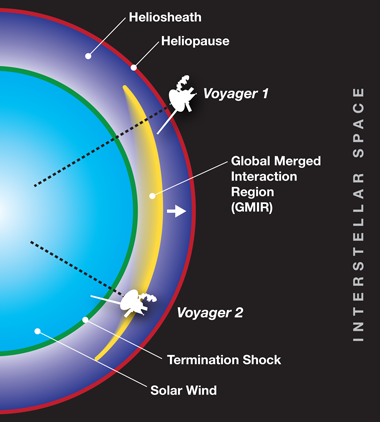We’re all living in a bubble.
In fact, the Sun and the entire solar system exist in a bubble that separates us from interstellar space. But what keeps that bubble inflated? A recent paper found that scientists can account for only 82% of the pressure that steadies the solar bubble, or heliosphere, against pressure from galactic headwinds. The source of 18% of the pressure is still unknown.
“It’s been a question for a long time how the pressure balance occurs. It determines the size of the entire heliosphere,” said Jamie Rankin, lead researcher on the project and an astrophysicist at Princeton University in Princeton, N.J.
Rankin and her team combined data from the Voyager 1 and Voyager 2 spacecraft taken at the edge of the solar system, called the heliosheath, with remote measurements of this region from other telescopes. They then calculated the region’s total pressure and figured out how much of that pressure comes from different types of particles.
“This is the first observationally inferred evidence of the total pressure out there in the heliosheath during this time period,” Rankin said.
Blowing Bubbles
Imagine, if you will, a large bubble submerged in a swimming pool. Water presses inward from all sides, and air pressure keeps the bubble inflated. The inside and outside spaces can interact only by passing things—particles, energy, pressure—through the air-water boundary. In doing so, the two sides alter the size, shape, and permeability of the bubble.
In this analogy, the heliosphere is the bubble, and the interstellar medium—the stuff between stars—is the water. In reality, the boundary between our solar system and the rest of the galaxy, the heliosheath, has a finite thickness. The heliosheath and its outward facing edge, the heliopause, deflect most interstellar particles from entering the solar system (see video at right).NASA’s Voyager 1 and Voyager 2 spacecraft, which were launched 42 years ago, have now traveled completely through the heliosheath and into interstellar space 20 billion kilometers away. In doing so, they have radically changed the picture of what inflates the solar bubble.
“The heliosphere is not just a closed system that’s blown out by the solar wind. It’s not the simplified version,” Rankin explained. The Voyagers found that outflowing pressure from the solar wind accounted for less than a quarter of the pressure needed to keep the bubble inflated. Some of the energy from solar wind particles was transferred to other outflowing particles, which made up some of the deficit.
Later studies of the heliosphere found that much of the remaining pressure comes from “neutral interstellar atoms that come in through the boundary,” she said. These so-called pickup ions “come in and eventually get energized by the solar wind, and then they’re carried back outwards. And it’s these particles that contribute a lot to the pressure. But they don’t explain the whole story, either.”
At the Edge
In 2012, an opportunity came to find out just how much of the story we were missing. Occasionally, a handful of individual solar ejection events join together as they travel to the edge of the solar system, like smaller weather fronts merging into one superstorm. One such solar superstorm, called a global merged interaction region, reached the heliosheath in 2012. A pressure wave rippled through the boundary, passing first Voyager 2 and then Voyager 1 four months later.

Voyager 2 was traveling through the inner reaches of the heliosheath at the time, but “we were very fortunate because Voyager 1 had just crossed the heliopause,” Rankin said. Measuring how the heliosheath responds to a disturbance like this one can reveal its fundamental properties.
As the wave passed by, each craft measured a decrease in the flux of incoming galactic cosmic rays. The researchers combined those cosmic ray measurements with past observations of the heliosheath from the Voyagers and other telescopes to find the speed of sound and total pressure at the boundary to interstellar space.
Using the Voyager data, the team found that the speed of sound in the heliosheath is roughly 310 kilometers per second, which is 1,000 times faster than the speed of sound through air on Earth. The total pressure in the heliosheath is about 270 femtopascals, about 4 billion trillion times lower than air pressure at sea level. The team published these results in the Astrophysical Journal on 25 September.
With a measurement of the total pressure, the team was able to parse out the contributions from different types of particles. Solar wind contributes 15% of the total pressure that keeps the solar bubble inflated. High-energy particles like cosmic rays provide 22%, and a whopping 45% comes from pickup ions, Rankin said.
That’s only 82% of the total pressure. “And then there’s 18% that we can’t account for yet,” she said.
Our Bubble of Space
The total pressure was higher than the team expected on the basis of models of the heliosheath. It’s possible that the heliosheath is thinner, its temperature is hotter, or its energy dissipation is weaker than expected. Any of those factors could alter the pressure calculation, the team explained.
Voyager 1, unfortunately, doesn’t have a working instrument to study the plasma just outside the solar system. “But Voyager 2 just crossed into the very local interstellar medium, so those data and what we can find out about the plasma environment out there can constrain some of these questions,” Rankin said.

Studying more events like the one from 2012, some of which were detected by the Voyagers, will help refine these calculations, according to the team. The Interstellar Boundary Explorer is also helping to create a holistic view of the heliosphere by putting the Voyagers’ local measurements into a global context.
“There’s the question of, if we were out in space looking back at our own solar system, what would that look like?” Rankin said. “Combining these two types of data sets gives us a really good picture of that.”
—Kimberly M. S. Cartier (@AstroKimCartier), Staff Writer






